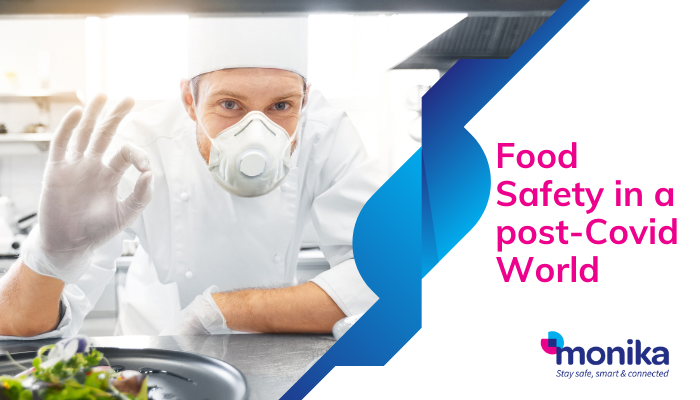
Although there is still a long way to go before we entirely defeat Covid-19 or, at the very least, find a way to co-exist with it safely, there are some silver linings in the cloud that Covid has placed over our world.
Along the journey so far, food operators have seen new practices emerge to keep people safe that could have broader benefits – including a reduction in foodborne illness.
As a case in point, the Australian Government recently reported a reduction in the number of notifications of national diseases in the first 6 months of 2020, compared to the previous 5 years. This includes fewer Salmonellosis, Listeriosis and Campylobacter infections, all of which have declined compared to the same period in 2019:
With this new finding in mind, we think it’s worth reflecting on which Covid-safe measures could, or should, become a permanent feature of our food safety programs in the future. We’ve identified some of the main ones below.
In a food operation, it makes a lot of sense from a safety point of view to keep staff and customers at a safe distance to prevent the spread of viruses and bacteria. Cramming food handling staff into a commercial kitchen like sardines just doesn’t seem to fit the picture of a ‘post-Covid world’.
It’s also possible that the way buildings and kitchens are designed could change: will kitchens be better segregated into ‘zones’ to prevent cross-contamination, or will there be a trend to having multiple, smaller kitchens on-site rather than one central production kitchen?
On the customer side, dining areas could continue to operate at a reduced capacity too, with a higher proportion of diners eating outdoors or meals being ordered for takeaway or home delivery. The effectiveness of ventilation systems may also come into play here.
From door handles to shopping trolleys and baskets, frequent surface sanitisation has been one of the biggest shifts in safety and hygiene across the board since Covid hit.
Customers are so much more hygiene-conscious now, and we don’t see this trend decreasing in the future. We can see reputable food establishments having ‘hygiene marshalls’ as a permanent fixture of their front-of-house team, seeing this as an investment in their brand and overall customer experience.
Sanitisation stations are most likely here to stay – and customers will no doubt continue to expect them to be in every store, hotel or food business. They may be self-service in many establishments, but ensuring they are continuously replenished and in good working order should be part of every business’s hygiene schedule.
If it isn’t already (and it should be), frequent, scheduled handwashing should be second nature, with systems in place to ensure adherence – whether that be an automated alarm or a verbal reminder from a staff member.
A long-term food safety trend that we see in a post-Covid world is a shift towards digital over manual, paper-based systems. This has been happening for some time, however, Covid-19 may give businesses the impetus to move forward in their digital transformation journey.
Wherever possible, food businesses need to ditch pen and paper and reduce manual tasks that involve staff coming into contact with surfaces. This is where a digital food safety system can help – staff no longer need to take manual temperature checks of fridges and freezers or use paper-based checklists for safety and hygiene tasks.
Digitisation of food safety and quality management records also supports remote or virtual auditing – reducing the time spent on site by management and auditors. This has been referred to as the ‘blended audit’ – combining the use of online technologies with physical inspections.
A little further into the future, we could see automation extend to food handling, with the use of robots and artificial intelligence to reduce human contact with food. “Robotic kitchens” could start to emerge – imagine your next pizza or salad being prepared by a robot!
Cashless payment seems to be the way of the future. It makes a lot of sense to remove cash from the equation, in the interests of staff and customer safety.
Making ordering and payment contactless could also become the norm, however, we don’t see this removing the human interaction between customers and staff altogether – as this underpins so much of what hospitality is all about. Perhaps technology will play a role here to fill the gap, allowing customers and staff to interact with some kind of physical barrier – be it a screen or device.
Illness is difficult to detect so it’s hard to know what measures could be used here, but we do see policies being more closely monitored and clearly communicated to staff to ensure they do not come to work sick and only return when it’s safe to do so.
We’ve seen some food businesses introduce temperature checks to ensure staff, suppliers, contractors and customers don’t enter premises unwell, but not consistently or across the board. If this was standard procedure in food operations it would send a very clear message – even if it isn’t a 100% effective method of detecting illness.
What changes do you see happening in food safety long-term as a result of Covid-19? Share your thoughts with us via info@monika.com.au
Find out how you can use a Monika digital food safety system to manage the many tasks associated with keeping people safe during a pandemic.
Contact us for a free demonstration, where we will show you exactly how it can work for you.
Monika has provided digital food and clinical safety solutions to healthcare and food service institutions worldwide since the early 1990s. Our product simulation technology originated from research conducted in an accredited laboratory on 100+ different product types.
Posted By
_1.png)